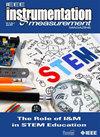解决非理想状态和 EIS 测量:从检查到实施
IF 1.6
4区 工程技术
Q3 ENGINEERING, ELECTRICAL & ELECTRONIC
引用次数: 0
摘要
金交叉指状电极(IDE)结构是一种常用的传感平台。利用非法拉第电化学阻抗谱法(non- faraday electrochemical impedance spectroscopy, nf-EIS)来提取被分析物的阻抗特性,而不需要氧化还原标签。许多跨学科的研究项目需要来自不同领域的学生,如电气工程、化学和/或生物学,来体验很容易在没有通知的情况下出错的电气测量。评估需要解决的内在和外在约束是至关重要的,以获得可靠和高质量的nf-EIS测量,这些测量在存在噪声和其他误差源的情况下也是可重复的。本文提供了一些例子,并总结了如何系统地解决普遍存在的非理想性的影响,使任何学生都能对他们执行的nf-EIS测量的解释和可靠性有信心。作为我们实验分析演示的一部分,进行了各种条件和体积优化以进行充分的测量。本文章由计算机程序翻译,如有差异,请以英文原文为准。
Addressing Non-Idealities and EIS Measurement: From Inspection to Implementation
Gold interdigitated electrode (IDE) structure is one of the commonly-used platforms for sensing. The response of IDE-based sensors is measured in different ways, of which non-faradaic electrochemical impedance spectroscopy (nf-EIS) is specially used to extract the analytes impedance characteristics without redox labels. Many research projects across various disciplines need students from different domains, such as Electrical Engineering, Chemistry, and/or Biology, to experience electrical measurements that can easily go wrong without notice. It is crucial to evaluate the intrinsic and extrinsic constraints that need to be resolved to get reliable and high-quality nf-EIS measurements, which are also reproducible in the presence of noise and other sources of error. This article provides examples and summarizes how to systematically address the effect of the commonly existing non-idealities to enable any student to get confidence in the interpretation and reliability of nf-EIS measurements they perform. As part of our experimental analysis demonstration, various conditions and volume optimization for adequate measurements are performed.
求助全文
通过发布文献求助,成功后即可免费获取论文全文。
去求助
来源期刊

IEEE Instrumentation & Measurement Magazine
工程技术-工程:电子与电气
CiteScore
4.20
自引率
4.80%
发文量
147
审稿时长
>12 weeks
期刊介绍:
IEEE Instrumentation & Measurement Magazine is a bimonthly publication. It publishes in February, April, June, August, October, and December of each year. The magazine covers a wide variety of topics in instrumentation, measurement, and systems that measure or instrument equipment or other systems. The magazine has the goal of providing readable introductions and overviews of technology in instrumentation and measurement to a wide engineering audience. It does this through articles, tutorials, columns, and departments. Its goal is to cross disciplines to encourage further research and development in instrumentation and measurement.
 求助内容:
求助内容: 应助结果提醒方式:
应助结果提醒方式:


